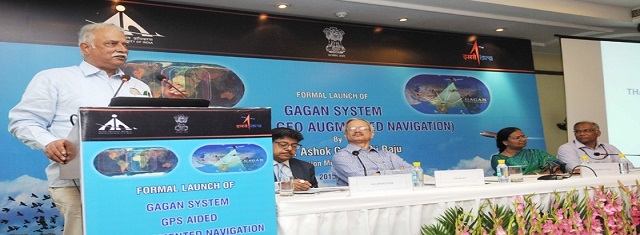News
Union Civil Aviation Minister Launches GAGAN System
GPS AIDED GEO AUGMENTED NAVIGATION

Mr. Ashok Gajapathi Raju addressing at the launch. (Source: PIB/GR/TYP/BIN/USPA/WN)
USPA NEWS -
The Union Minister for Civil Aviation, Mr. Ashok Gajapathi Raju Pusapati addressing at the launch of the GAGAN System for aviation use, in New Delhi on July 13, 2015. The Minister congratulated the entire team on development of the GAGAN project.
Union Minister of Civil Aviation, Mr. P Ashok Gajapathi Raju, formally launched the GAGAN system (GPS AIDED GEO AUGMENTED NAVIGATION) at a function on July 13. Speaking on the occasion, the Minister congratulated the entire team on development of the GAGAN project.
GAGAN is the first SBAS (Satellite Based Augmentation System) in the world certified for Approach with Vertical Guidance operating in the Equatorial Ionospheric region and the third SBAS to have achieved this feat, after WAAS of USA and EGNOS of Europe. GAGAN was already certified for en route operation since 30th December 2013.
GAGAN is the first SBAS (Satellite Based Augmentation System) in the world certified for Approach with Vertical Guidance operating in the Equatorial Ionospheric region and the third SBAS to have achieved this feat, after WAAS of USA and EGNOS of Europe. GAGAN was already certified for en route operation since 30th December 2013.
GAGAN is a joint effort of Airport Authority of India (AAI) and Indian Space Research Organization (ISRO). In the aviation field, GAGAN will support more direct air routes, reduce fuel consumption and improve safety. In addition, GAGAN provides benefits to agriculture, all modes of transportation and public services such a defence services, security agencies and disaster recovery management by aiding in search and rescue to locate the disaster zone accurately.
Since 14th February 2014, GAGAN has been continuously providing navigation signals from GSAT-8 and GSAT-10 satellites launched by ISRO, augmenting the performance of GPS signals received over Indian Airspace.
Mr. RN Choubey, Secretary, Ministry of Civil Aviation, Mrs. M Sathiyavathy, Director General of Civil Aviation, Mr. RK Srivastava, Chairman, Airports Authority of India, Dr. YVN Krishnamurthy, Scientific Secretary, ISRO were also present on the occasion.
Mr. RN Choubey, Secretary, Ministry of Civil Aviation, Mrs. M Sathiyavathy, Director General of Civil Aviation, Mr. RK Srivastava, Chairman, Airports Authority of India, Dr. YVN Krishnamurthy, Scientific Secretary, ISRO were also present on the occasion.
Liability for this article lies with the author, who also holds the copyright. Editorial content from USPA may be quoted on other websites as long as the quote comprises no more than 5% of the entire text, is marked as such and the source is named (via hyperlink).





